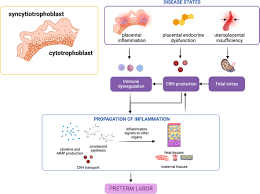Maternal Plasma Lipid Profile as a Potential Risk Factor for Spontaneous Preterm Labor
DOI:
https://doi.org/10.69667/rmj.25204Keywords:
Spontaneous Preterm Labor, Term Pregnancy, Lipid Profile.Abstract
This study seeks to assess whether the maternal plasma lipid profile acts as a risk factor for spontaneous preterm labor. In this hospital-based retrospective case-control research, 70 pregnant women were included in 35 cases of spontaneous preterm labor and 35 cases of term pregnancy who had labor pain and were admitted to the Maternity and Children Hospital (MCH) for delivery between January 2023 to January 2024. We used the logistic regression method to determine the plasma lipid profile for risk factors of spontaneous preterm labor. The case group had significantly higher plasma levels of low-density lipoprotein, triglycerides, and total cholesterol, 31.4%, 45.7%, and 17.1% than the control group, respectively. All the potentially risk factors with their p-value ≤0.05 were taken for logistic regression. linear regression the elevated levels of triglyceride, total cholesterol, and low-density lipoprotein was detected to be associated with 2.92-fold (1.62‑3.24,95% CI, p < 0.001), 3.31-fold (1.30‑4.99,95% CI, p = 0.001) and 2.88-fold (1.75‑3.19,95% CI, p = 0.002) higher risk of premature labor, respectively. A higher risk of spontaneous preterm labor may be associated with elevated serum levels of triglycerides, total cholesterol, and low-density lipoprotein, which could be regarded as a risk factor for this pregnancy issue.

Downloads
Published
Issue
Section
How to Cite
Similar Articles
- Fozia Aborayana, Fadila Elghadban, Souad Aboalqasim, Insulin-Dependent Diabetes Mellitus and the Pregnancy Outcomes: A Retrospective Study in the Pediatrics Department of Tripoli University Hospital – Tripoli, Libya , Razi Medical Journal: Volume 1, Issue 2, 2025
- Mahmoud Ashawesh, Mustafa Alkawash, Ayah Meigal, Baraah Almsiri, Abtihal Almasalati, Tracking the Burden of Type 2 Diabetes Mellitus Among Libyan Patients in Three Populated Districts of Tripoli, Libya , Razi Medical Journal: Volume 1, Issue 4, 2025 (October to December)
- Asma Buzgeia, Nazik Hamad, Emaduldin Ateeyah, Mohamed Mohamed, Mohamed EL Fakhri, Utilizing Resources of Drug Information among Community Pharmacists in Benghazi and the Surroundings , Razi Medical Journal: Volume 1, Issue 2, 2025
- Amhamad Alhajaji, Salem Almiladi, Ahmed Alhammali, Surgical Repair of Congenital Chest Wall Deformity (Pectus Excavatum): A 20-Year Multicenter Experience , Razi Medical Journal: Volume 1, Issue 1, 2025
- Hawa Abduljalil, Tarik Enaairi, Striae Gravidarum and Its Effect on the Quality of Life Index in Libyan Pregnant Women , Razi Medical Journal: Volume 1, Issue 1, 2025
- Ahmed Alsharksi, Abdalla Ali, Adam Mustapha, Muna Alshagmani, Bacterial Profile and Their Antimicrobial Susceptibility Pattern of Isolates Recovered from Intensive Care Units of Libyan Hospitals. , Razi Medical Journal: Volume 1, Issue 3, 2025
- Wadiaa Benamer, Tamader Elghnimi, Mustafa Targhi, Loujain Husnein, Ussra Ben Enbaya, Women's Awareness of Contraceptives in Tripoli City: A Field Study , Razi Medical Journal: Volume 1, Issue 3, 2025
- Raja Moman, Nouralhuda Altair, Abdulkarem Tamer, Amnnah Ghalbun, Nagat EL-Magrahi, Antibiosis of Antibiotics, Honey and Probiotics Related Bacteria to Diabetic Foot Infections , Razi Medical Journal: Volume 1, Issue 1, 2025
- Abulgasem Dakhil, Mohamed Abuagela, Abdul Aty Dakhil, Wasim Elarbi, Aisha Elansari, Evaluation of Uterine Fibroids Among Women in Tripoli , Razi Medical Journal: Volume 1, Issue 2, 2025
- Mufeedah Mansour, Khoulah Alaribi, Prevalence and Outcomes of Coagulase-Negative Staphylococci in Newborns Admitted to the NICU in a Tertiary Hospital in Libya , Razi Medical Journal: Volume 1, Issue 2, 2025
You may also start an advanced similarity search for this article.








